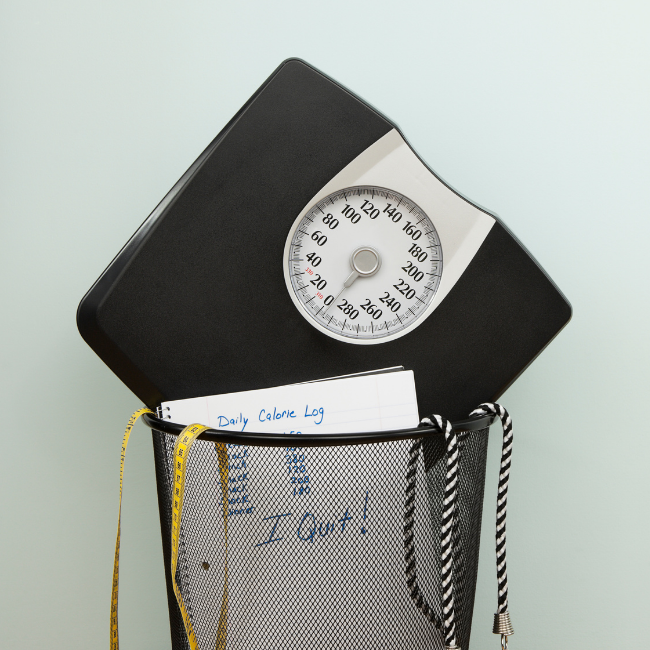Trying to hit your health goals but keep running into roadblocks? It may be time to have a good, hard look at what you’re doing and be honest about any self-sabotage that may be happening.
Let’s be real for a minute—the road to getting healthy isn’t always a smooth path. There are bound to be bumps along the way, and every new challenge can sometimes make it feel like the deck is stacked against us.
But what if I told you that your BIGGEST challenge when it comes to significantly changing your life isn’t actually all those outside factors, but something much more INTERNAL?
Specifically—what’s going on inside your own head.
Are you ready to lose weight and heal your body for life (without dieting, drugs, or making yourself miserable)?

Our free on-demand video training will walk you through how to make this THE year you set health goals…and keep them.
The truth is that the biggest danger most of us face on the road to getting healthy is OURSELVES.
And that’s why in today’s post, we’re taking a deep dive into self-sabotage—what it looks like, and more importantly, how to avoid it.
This is a topic that comes up SO much for so many of us, whether you’re just getting started on your journey to get healthy, or whether you’ve been doing this for a while.
Self-sabotage is all the ways that we tend to derail our own progress by not dealing with the stuff that’s happening inside our head.
At the end of the day, SO much of our ultimate success in any endeavor in life (but especially in this journey to lose weight and take control of our health) often comes down to our mental fortitude and our willingness to actually BELIEVE that change is truly possible.
But sometimes old habits die hard, and there are often ways that we begin to undermine our progress without even realizing it.
So let’s dive into all of that today—all the ways we tend to self-sabotage, what that looks like, and, more importantly, some of the practical steps we can take to AVOID self-sabotage in our journey to better health.

Psst.. if you are new here, I have a little gift for you! It’s a free starter guide called Flip the Switch. I go into detail about our approach to weight loss and the science behind our program here at Thinlicious. I’ll share why it works, and why, if you’ve hit a certain age, it probably feels like your metabolism has stopped working. And it’s totally free to download!
What is self-sabotage?
So first things first—what exactly IS self-sabotage, and what does it look like?
Honestly, self-sabotage looks a little bit different for everyone. So, while it might be easy to recognize self-sabotaging behavior in OTHER people, it’s not always so easy to see it in ourselves.
After all, we’re usually the LAST people to realize how much we’re actually holding ourselves back, and that can be a really scary thing.
But for most of us, it’s those habits and behaviors that we do (or don’t do) without even realizing it that eventually lead to us undoing all the good progress we’ve made.
So here are just a few of the most common types of self-sabotage I’ve seen or been guilty of in my own life—and I’m willing to bet that some of these will sound very familiar.
Negative self-talk
First up is all that negative self-talk that happens inside our head. This is that little voice in the back of our brain that tells us we can’t do something, or that we’re not good enough, or that it’s impossible to actually stick with this for any length of time.
And the truth is that this type of negative self-talk can be just as damaging to our progress as anything else.
In fact, often this little voice will start taking over and derailing us when we least expected, especially when our guard is down or we have a little setback, but even when things are going great and we’re doing well.
Procrastination
The second type of self sabotage I see a lot is procrastination and just flat out avoidance.
This looks like not getting started on something, or putting it off for another day, or coming up with any number of reasons why we’re not really ready.
It’s totally understandable that sometimes we need more time, or more information, or a better plan in place.
But, at the end of the day, if we’re constantly making excuses for why we can’t start something, then it becomes pretty clear that our own inaction is what’s really holding us back.
Self-sabotaging with comparison
A third type of self-sabotage is comparison. This is where we compare our own progress or lack thereof to that of someone else, and then beat ourselves up for not measuring up.
This type of self-sabotage can be especially damaging because it’s so easy to do, but also so detrimental to our progress—because when we compare ourselves to others, we’re never comparing like with like.
We end up comparing our worst moments to someone else’s best, and that just isn’t fair—to us or to them.
Fear of failure
Yet ANOTHER big type of self-sabotage I want to talk about is fear of failure. Often this is where we let our fear of not achieving something stop us from even trying in the first place.
This kind of fear is totally understandable—after all, who wants to put in the effort and then fail?
But when it becomes the thing that keeps you from actually getting started, then it’s definitely something you’ll want to address.
Fear of success
Closely related to fear of failure is what I call the fear of success.
This is where we might actually start to see some real progress but suddenly become afraid of actually achieving something. Why? Because it means that our lives or our circumstances have to change in some way.
That can be a really scary prospect, so we can often start to subconsciously undermine our progress in order to ensure that we don’t actually reach our goals.
Self-sabotaging with all-or-nothing thinking
Another type of self-sabotage I’ve seen a lot is an “all or nothing” mindset where you decide that if you can’t do something perfectly, then there’s no point in trying at all.
This is where people will say things like, “If I can’t do it 100%, if I can’t count my macros perfectly or if I can’t have the BEST possible workout, then there’s no point in doing it at all.”
That kind of thinking will literally stop you dead in your tracks every single time.
Excuse making
These are those “I deserve it” excuses—you know the ones where you tell yourself just one more treat won’t hurt, or that working out isn’t worth your time because you’ve already done so much today.
This type of excuse-making is usually the result of fatigue or overwhelm, and while it’s totally understandable that sometimes we need to give ourselves a break, it’s important to remember that these excuses can become a habit if left unchecked.
While I’m sure there are probably more, those are just some of the most common underlying types of self-sabotage I’ve seen in my own life and for our Thinlicious customers.
But how those tend to manifest in our own lives can be very different.
Signs & symptoms of self-sabotaging behavior
Let’s talk about some of the most common signs and symptoms of self-sabotage so you can have a better idea of what to look out for in YOUR life.
1. Feeling stuck
The first sign or symptom to watch out for is when you feel like you’re just not making any real progress, even though you’re putting in the work.
That’s usually a sign that something is off, either internally or externally. It’s also when that little voice of self-doubt can start to creep in, and that little voice is often what gets us into trouble.
2. Constantly shifting goals
The next symptom to watch out for is when your goal posts keep changing and moving further and further away from you even though you’re actually moving forward and making progress.
This happens when you’re only looking forward at how far you have to go, but not celebrating your wins or recognizing how far you’ve come.
3. Self sabotaging through procrastination
Another big one is avoiding or procrastinating on certain tasks, especially the ones you know are most important. Even little things, like planning your meals or going to the grocery store so that you know you have the right foods on hand.
If your fear of failure or success is keeping you from doing some of the basic tasks needed to continue to be successful, then that’s definitely a big red flag.
4. Falling back into old habits
It could also be allowing yourself to slip into old patterns or habits.
If you’re noticing that when things get tough, or you don’t have the right support in place, or something shifts in your life, that suddenly you find yourself reverting back to old behaviors (like emotional eating or skipping workouts) that’s a sign of self-sabotage that needs to be addressed.
5. Beating yourself up over slip-ups
And finally, another sign of self-sabotage is constantly beating yourself up for mistakes and failures.
The reality is that we’re all going to have moments of weakness, but that in and of itself is not necessarily self-sabotage. The self-sabotage happens when you use that momentary slip-up to become a reason to beat yourself up, or even to quit.
Strategies to avoid self-sabotage
So then, of course, the question becomes, what do you do when you recognize these signs in yourself?
I think, honestly, the first step is really just SELF-AWARENESS. It’s to simply start paying attention and really acknowledging that we all have a tendency to self-sabotage without really realizing it.
Once you know your tendencies, you can be prepared to identify potentially self-destructive behavior before it actually derails you.
That said, I think there are also a lot of practical strategies you can put in place to keep yourself on track and avoid stepping into some of those mindset traps.
It’s almost like you have to train your brain to let success rather than failure become a habit. So let’s talk about some of those practical things you can do.
1. Set realistic goals and milestones
Start by setting realistic goals and milestones for yourself. Because honestly, there’s nothing more DE-movitating than setting goals that feel completely unattainable.
And let me say more about this because this is coming from someone who is a BIG believer in setting big goals.
If you’ve listened to the Do It Scared podcast or read any of my books or used my Living Well Planner, you probably know that I talk about BIG goals all the time.
In fact, there are few things I love more than a big hairy audacious goal—also known as a BHAG—as something to shoot for FAR in the future. I think BIG goals that really scare you, that feel a little bit out of reach, are awesome motivators.
How to tackle BIG goals
But I also feel really strongly that BIG goals can be a problem if you don’t also have a way of breaking down those bigger goals into manageable bites and more realistic milestones.
Otherwise, those big goals just become this thing that feels so large and unattainable that you’ll never actually get there.
When it comes to your health, and especially to losing weight, there are times where the body is going to do what it is going to do. You can’t really rush the process.
You didn’t become unhealthy and overweight overnight; you didn’t just wake up one morning 50 pounds overweight with inflammation and a leaky gut and insulin resistance; all of that took years and years of effort.
And that means that REVERSING all that damage might take a while too.
That can feel SO frustrating when you feel like you’re working SO hard and doing all the right things, and things aren’t happening as fast as you want them to. Whether we realize it or not, we often have this expectation that the weight will just start melting off the minute we start focusing on it.
Break up big goals into smaller attainable goals
As I’ve talked about before, sometimes that initial fast water weight loss can set us up for future disappointment when the actual FAT comes off more slowly. That’s why it’s REALLY important to set some realistic expectations and milestones for your health journey.
It’s fine to set a BIG GOAL of losing 100 pounds, but know from the get-go that losing 100 pounds in a healthy, sustainable way might take you up to a year or more.
And that’s actually okay because it’s giving your bones and muscles and skin a chance to adjust to your new size. In the meantime, set smaller goals that feel more attainable.
Focus first on losing 20 pounds, then 50, and so on.
Focus on other non-scale goals, like:
- being able to walk up a flight of stairs without getting winded
- tracking your macros for 30 days in a row
- being able to tighten a notch in your belt
Make sure you’re setting some realistic goals and milestones that actually feel attainable, even if you have a bigger long-term goal.
2. Track your progress in a number of different ways
The next strategy for avoiding self-sabotage is to actually TRACK your progress. You can do this in a variety of ways.
I say this all the time: you can only improve what you actually measure.
Plus, tracking your progress in at least a few different ways helps you to actually SEE that real progress is happening, however slowly, beyond just the number on the scale.
So what things could you actually track besides just your weight?
Well, there’s lots of things!
Snap photos of yourself
One thing I ALWAYS recommend (even though I know SO many people try to avoid it) is to take regular photos along the way!
These don’t have to be photos that you ever share with anyone, but it’s SO amazing to be able to actually compare side-by-side photos from different points in your journey.
I know it doesn’t seem like it now, but if you’re just getting started, you WILL, at some point, want to be able to see the difference! Do your future healthy self a favor and just take the photo!
Track your measurements
Another helpful thing to track is your basic measurements—waist, hips, bust, and even your arms and legs.
Obviously, this isn’t something you’ll want to do daily, but once a month or every couple of months is a good way to see progress that isn’t always visible on a day-to-day basis.
At my gym, I work out with a trainer a few days a week, and one of the perks of that is being able to do regular full-body scans. Being able to measure my progress in that way and now, several years into my health journey, being able to compare side by side where I was in terms of measurements and even body fat percentage is SO awesome.
It just makes me realize how much I never want to go back to that.
Take note of how you feel
Another great thing to be tracking is more of an internal thing—how you actually FEEL. Keep track of how you feel when you start and how you feel along the way.
Where are you experiencing pain? What hurts? What feels hard? What’s your energy like? And as you go, what are you able to do now that you weren’t a month ago or 3 months ago?
Sometimes when those changes happen slowly, you’re not always aware. We tend to focus on how we feel right now, so you might not always remember just how bad you felt.
Have your numbers checked
Then, of course, there’s your blood work and your medical numbers such as:
- blood pressure
- cholesterol
- blood glucose
In our Thin Adapted System program, we recommend getting some blood work as you’re getting started, then having that checked every few months or so.
Let me tell you…it’s pretty amazing to see those numbers start to improve and realize that this really isn’t about weight loss. It really is all about transforming your health and changing your future, and not dooming yourself to a lifetime of medication and feeling sick and tired all the time.
So keep track of these things. Give yourself a way of measuring ALL your victories, not just the ones on the scale.
3. Reward yourself along the way
Along those lines, the third thing I recommend is to find ways of rewarding yourself along the way with your small milestones and victories, not just the big ones.
We can be so quick to get discouraged when we don’t feel like things are happening fast enough, but the reality is that every victory should be CELEBRATED because transforming your health is a HUGE DEAL.
Make a list of things you want and ways that you can reward yourself. Obviously, these rewards should ideally not be food related, since that in and of itself would be a form of self-sabotage.
So maybe it’s a new purse or a new pair of shoes. Maybe it’s a massage or a facial or some botox. Maybe it’s new perfume or some new makeup. Or maybe it’s a new hairstyle.
And as the pounds do start to come off, and your clothes start to get too big—BUY SOME NEW CLOTHES.
You don’t have to spend a fortune—you can go to the thrift store or a consignment shop. But have at least a few outfits in your new size that make you feel great, stylish, and beautiful.
Reward yourself by GETTING RID of the old sizes that don’t fit. You might even need to do this a few times if you have a lot of weight to lose, but that’s okay.
It’s amazing what that will do for your mindset when you realize that there’s no reason you’ll ever need to go back to those old sizes.
So reward yourself along the way, and do it regularly. That’s important.

4. Remind yourself that consistency matters more than perfection
That said, it’s ALSO important to keep reminding yourself that CONSISTENCY is the thing that will get you to where you want to go, and that consistency is SO much more important than perfection.
You won’t always be perfect. Sometimes you’ll just have to make the best possible choice in a shitty situation.
Sometimes your macros will be off.
And yes…sometimes you’ll fall off the wagon or eat the cookie or that slice of pizza.
That’s where you’ll be tempted to beat yourself up or use it as an excuse to just go off the rails. But you’ve got to keep reminding yourself that you’re in it for the long haul.
I say this all the time—big goals NEVER happen all at once. They are only the result of small steps taken consistently over time. Always.
So recommit to yourself every single morning that today you will make the next best choice. Today you’ll keep going.
Over time, those small choices will add up to a huge change.
Sometimes, it can even be helpful to put up visual cues to remind yourself of that. A sign on your fridge that says “make the next best choice” or a screen saver on your phone or whatever.
Make THAT the voice in your head—the one that’s reminding you, over and over, that consistency matters so much more than perfection.
5. Improve your mindset
Of course what that really comes down to is my next thing, which is just actively working on developing a healthy weight loss mindset.
In the end, it’s always going to come down to your mindset and your ability to change your thoughts and let go of those negative thought patterns.
I think mindset is something we all need to constantly be working on because life is hard. There are moments where things just SUCK, and we feel beaten down and exhausted and discouraged.
But improving your mindset is like building muscles—it’s something you have to flex and work on.
For me, that often means listening to inspirational podcasts and audiobooks. I love listening while I’m doing other things like walking my dogs or driving.
If you need some recommendations, I’ll tell you that I’d definitely start with my own book Do It Scared, and there’s also my Do It Scared podcast. But, some other books that have really inspired me along the way are:
- Believe It by Jamie Kern Lima
- Atomic Habits by James Clear
- The Alter Ego Effect by Todd Herman
- Extreme Ownership by Jocko Willink
- The Obstacle is the Way by Ryan Holiday
Keep working on your mindset. Fill your head with positive messages so there’s less room for self-doubt and negative self-talk.
6. Seek out social support
And I know this is getting kinda long, so I’ll wrap it up, but the last thing I want to mention, just because I think it is so so SO important in life in general, ESPECIALLY when you are trying to make big, positive changes in your life like transforming your health, is to SEEK OUT SOCIAL SUPPORT.
Find your people. Find the people who are going to lift you up, not tear you down.
Surround yourself with encouragers and motivators and people who just GET IT.
It’s been said many times that we are the sum total of the 5 people we hang out with the most, so make sure there are at least five people in your life who are inspiring you and motivating you to keep going.
Limit your exposure to the negative influences who aren’t supporting your journey because life is too short for toxic relationships.
If you find that your real-life circle is full of people who aren’t really growth-oriented and who are stuck in their old ways, and want you to stay stuck there too, then here’s a tough truth…
You might have to move on and be okay with letting some of those relationships go.
At the same time, make sure you are actively seeking those POSITIVE influences in your life—like the community within our TAS program.
Probably one of the biggest things that makes it SO effective is the amazing support of our community and the fact that you can regularly talk to and connect with other like-minded women who are on a similar journey.
Even though it’s an online program, we’re starting to see the members of our community connect more and more in real life. They’ll actually go meet up in in person, and that’s pretty freaking cool to see.
There’s nothing quite like having friends to cheer you on and keep you strong. So seek out that social support, because it matters.
Final thoughts on self-sabotage
In the end, avoiding self-sabotage is all about being intentional with your actions and mindful of your thoughts.
It’s about making the next best choice every single day, surrounding yourself with positive influences, and improving your mindset so that you can stay strong through those challenging moments.
And it’s also a choice. The choice to keep going, no matter what.
If you can do that, then I have no doubt that you will be successful in reaching whatever goals you set for yourself.
Next Steps
Ready to take the next steps in defeating self-sabotaging? Here are a few actions to take.
Learn more
Ready to lose weight and get healthy for life without dieting, drugs or making yourself miserable? Our brand new (and totally free!) on demand video training will help you understand why it’s been so hard and what do to about it.
Join the conversation
I’d love to get a conversation going about this topic in our Thinlicious Facebook group! So if you’re in there, please share your thoughts!
Do you struggle with self-sabotage? If so, what are the ways you tend to notice it? And is there anything that has really helped you stay on track in your own journey to get healthy?
Listen to the podcast
If you liked this post, you’ll also absolutely LOVE the podcast I have on this topic. Listen to the Ditch the Carbs podcast HERE!
Share with a friend
If this content was helpful to you, please be sure to pass it on to anyone in your life who you think could benefit. Send the link in a text or via email, or just share it on social.
I SO believe that helping people transform their health is the way to change the world, and I hope you’ll join me on that mission.
I will see you back here very soon for our next topic.
Bye, friends!
What if you could actually take control of
your health in just 10 days?
It’s not your fault you can’t lose weight as a woman over 40 even though you’ve likely tried literally everything. Your metabolism probably feels broken and your hormones are likely all out of whack.
But you can fix it all with ONE simple change: eliminate sugar. We make it super easy with daily lessons teaching you the science behind what makes us gain weight in our midlife and beyond! Are you ready to get started now?














